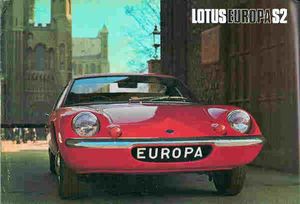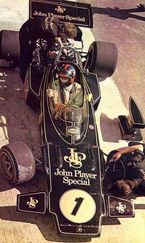.
Lotus Europa

| |
| Lotus Europa | |
|---|---|
| Lotus | |
| aka | Lotus Europe, Lotus Europa, Type 46, Type 54, Type 65, Type 74 |
| Production | December 1966-August 1975 est. 9230 produced |
| Class | Sport |
| Body Style | 2 Dr. coupe |
| Length | length - type here |
| Width | Width - type here |
| Height | 42 in |
| Wheelbase | wheelbase - type here |
| Weight | Light. 1400-1600 lbs |
| Transmission | S1/S2 4-speed, TC/TCS 4 or 5 speed, all sourced from Renault |
| Engine | S1/S2 1470 or 1565 Modified Renault R16, TC/TCS Lotus-Ford Twin Cam |
| Power | N/A hp @ N/A rpm N/A lb-ft of torque @ N/A rpm |
| Similar | Porsche 914 |
| Designer | Ron Hickman John Frayling |
The Lotus Europa, or Europe in its initial export-only guise, was a two door mid-engined GT coupe built by Lotus Cars from 1966 to 1975.
The original Europa used Lotus founder Colin Chapman's steel backbone chassis concept that was first used in the Lotus Elan, while also relying on its fibreglass moulded body for structural strength. The Europa was the world's first mass-produced mid-engine road car and was based on a prototype built to compete for Henry Ford II's contract to build a Le Mans race car, which Ford later introduced as the GT40, in the early 1960s.
The concept originated during 1963 with drawings by Ron Hickman, director of Lotus Engineering (Designer of the original Lotus Elan, as well as inventor of the Black and Decker Workmate), for a bid on the Ford GT40 project. That contract went to Lola as Colin Chapman wanted to call the car a Lotus and Henry Ford II insisted it would be called Ford. Chapman chose to use Hickman's aerodynamic design (with a still respectable, even today, drag coefficient of Cd 0.29) as the basis for the Europa production model which was originally intended to replace the Lotus 7.
The Europa was designed and built to be an embodiment of Chapman's oft-stated philosophy of automotive design: "Simplify, then add lightness." The 4-wheel independent suspension was typical of Chapman's thinking; the rear suspension consisted of two relatively large trailing arms, one lower locating link per side, and the axles were used as upper locating links, which was very similar to Formula racing car designs of that era. Aside from the doors, bonnet (hood), and trunk (boot), the body was installed on the chassis as a single unit of fibreglass.
The car's handling prompted automotive writers to describe the Europa as the nearest thing to a Formula car for the road.
In all, Lotus built about 9,300 Europas of all variants.
See Wikicars' comprehensive Lotus Europa Review
Recent Changes
Mention any minor facelifts or major changes made to the vehicle here.
Styles and Major Options
Certain vehicles come in different trim levels or body styles. Features and major options should be mentioned here.
Pricing
Add more fields as necessary.
| MODEL Trims | |||
|---|---|---|---|
| Trim1 | Trim2 | Trim3 | Trim4 |
| MSRP | |||
| $Price1 | $Price2 | $Price3 | $Price4 |
| Invoice | |||
| $Price1 | $Price2 | $Price3 | $Price4 |
Gas Mileage
Add more fields as necessary.
As seen on the FuelEconomy.gov website, the City/Highway MPG averages are as follows:
| Trim | |||
|---|---|---|---|
| Trim1 | Trim2 | Trim3 | Trim4 |
| MPG | |||
| c/h | c/h | c/h | c/h |
Engine and Transmission
Specifications, details, graphs, pictures and other information regarding the powertrain is placed in this section.
Performance
Please make sure to write information of the vehicle's performance in a third-person point of view. This section should include information about the car's acceleration figures, handling, braking, etc.
If using information gathered from Road Test articles from a reputable automotive source, then please make sure to cite the quote.
Reliability
Warranty options and scheduled maintainence information should be mentioned here.
Safety
This section should reference points on safety ratings and features of the vehicle.
Photos
- Lotus Europa S1 Typ46.JPG
1967 Lotus Europa S1 first Series.
Add Photos of the vehicle here.
Please make sure not to use copyrighted photos.
Colors
List the colors that the particular <MODEL> is offered in.
Main Competitors
Create links to other <MAKE> <MODEL> pages in this section.
Hybrid Models
If there are hybrid versions of this vehicle manufactured, then please elaborate a little bit on it here.
Unique Attributes
The Lotuss Europae is a small light-weight flower, usually black with gold striping, found predominantly in barns and garages throughout North America, frequently in multiple baskets. It has eight valves and two "bump sticks" thought to manage air flow and reproduction. Its origins are believed to have been from a part of the world near what is today called "Londonistan."
Interior
This section should include information on the interior's design, build quality, ergonomics, space (head and legroom, front and rear), features, stowage compartments and overall comfortability and livability. Add pictures wherever applicable and keep information in a third-person point of view.
Resale Values
Add more fields as necessary.
| <MODEL> Year | |||
|---|---|---|---|
| Year X | Year X-2 | Year X-3 | Year X-4 |
| Resale Value | |||
| $ | $ | $ | $ |
Criticisms
Please make sure to keep critiques in a third-person point of view. If using criticisms from a reputable automotive source, then please make sure to cite the quote.
Generations
Fill in as many as appropriate. Add more if necessary and pictures wherever applicable.
Please make sure NOT to use copyrighted pictures.
Second Generation: (2006–present)
- see Lotus Europa S
First Generation/Origins (1966-1975)
Series 1 (Type 46) Type change points: Series I from Chassis Number 46/0001 to 46/0299 excluding 0270, 0271 & 0272 Series I Mk.I from Chassis Number 46/0300 to 46/0644 including 0270, 0271 & 0272
The Series 1 or S1 Europa (also known as Lotus Type 46) was announced for sale to European markets on December 20, 1966. The first cars were delivered in France in February 1967, sold as Lotus Europe. The S1 was fitted with a modified Renault 16 1470 cc engine and a 4-speed gearbox. The engine was a special 82 hp version (as opposed to the 52 hp generated in standard form). Lotus turned the engine and gearbox through 180 degrees to accommodate the Europa's longitudinal mid-engined layout, inverting the gearbox's crown wheel and its pinion gear to avoid having four reverse gears. The S1 weighed 1512 lbs, had a top speed of 110 mph, and did 0.60 mph in 10 seconds. Of particular note, nearly 0.9 g lateral acceleration was achieved on road tires of that era.
Variations:
46 - S1 - First Europa - Lancia Flavia taillights, Aluminum dash. Fully enclosed chassis. Fixed windows. Stopped at 460299 46 - S1A - Same as S1 but with wood dash. Pop-out windows. Stopped at 460540 46- S1B - Same as S1A but with S2 taillights. Stopped at 460644 47 - Racing 46 - Twin cam engine. Rear disc brakes at the gearbox 644 Europa S1s for the street were manufactured.
Series 2 (Types 54 & 65)
Type change points:
Series II from Chassis Number 54/0645
Series II Federal from Chassis Number 54/1066
The Europa S2, or Type 54, was introduced in April 1968. It used the same Renault engine as the Type 46, but offered a number of refinements, including electric windows, fully adjustable seats, a new interior, and a polished wooden facia for the dashboard. Per request of the automotive insurance industry, Lotus switched to bolts (instead of resin bonding) to attach the body to the frame. A small number of Type 54s were modified to be "federalized", that is, made suitable for export to the United States.
In 1969 the Type 65, or S2 Federal, was born with additional changes to the body, chassis, and powerplant to better comply with U.S. D.O.T. standards. Among the changes, the Renault engine was expanded to 1565 cc capacity over the previous 1470 cc. Road&Track Magazine tested the Federal S2 and recorded 0-60 mph in 9.6 seconds with a top speed of 116 mph.
Variations:
54 - S2 - Early - No parking light binnacles in the front. No rear side markers. 46 style front side markers. Single wiper. Power windows. Started at 540645. Stopped around #541070 54 - S2 - Late - 65 parking light binnacles in the front. 65 style side marker lights. Dual wipers. Stopped around 542859 62 - Racer. Only 2 built 65 - S2 - Late - Federalized S2 with raised headlight height by adjusting top line of front fenders and longer springs, emission-controlled R16 engine, but includes all the improvements brought forward from the 46 into the 54 and ROW 65 3,615 S2s were produced
Twin Cam and Special
In 1971, the Type 74 Europa Twin Cam was made available to the public, with a 115 hp 1558 cc "big valve" Lotus-Ford Twin Cam engine (105 hp to comply with US Federal emissions controls until the end of production), a new Renault 4-speed gearbox (Type 352) and a re-designed bodyshell to improve rearward visibility. Mike Kimberley, who rose to become chief executive of Group Lotus, then a new engineer at Lotus, was appointed Chief Engineer of the Europa TC project. 1,580 cars were shipped as the Europa Twin Cam before Lotus switched to a 126 hp, Dellorto/Weber carbureted version of the same engine; in addition to offering a new Renault 5-speed (Type 365) gearbox option; and renamed the car Europa Special. It weighed 740 kg (1631 lb), had a top speed of 123 mph, did 0.60 mph in 7.0 seconds, and ran the 1/4mile in 14.9 sec. A total of 3,130 Specials were manufactured.
To honor Team Lotus's 1972 and 1973 F1 World Championships, a few black with gold pin stripe and numbered badge Europa Specials were offered as the first ever "John Player Special" commemorative motor vehicles.
Variations:
74 - TC - Low sails. Larger cabin (deeper). Front track increased 1" and frame deepened. Introduction of the Twin Cam engine. Maintained 1.25" rear brake shoes from S2. Brake servos standard. 74 - TCS - Rear brake shoe width increased to 1.5". Special pinstriping. Lower body sills in sliver metalflake.
Worldwide
If the vehicle is sold in other markets worldwide, then this is the section to mention that information. Also, mention if the <MODEL> goes by another name in these other markets.
Design quirks and oddities
Refer to any pop-culture tidbits about the vehicle in this section.
Awards
List out notable awards that the model has recieved while in production. Boldface the company or organization that gives out the award, and Italicize the name of the award.
See Also
External Links
Please include any external sites that were used in collaborating this data, including manufacturer sites, in this section.



